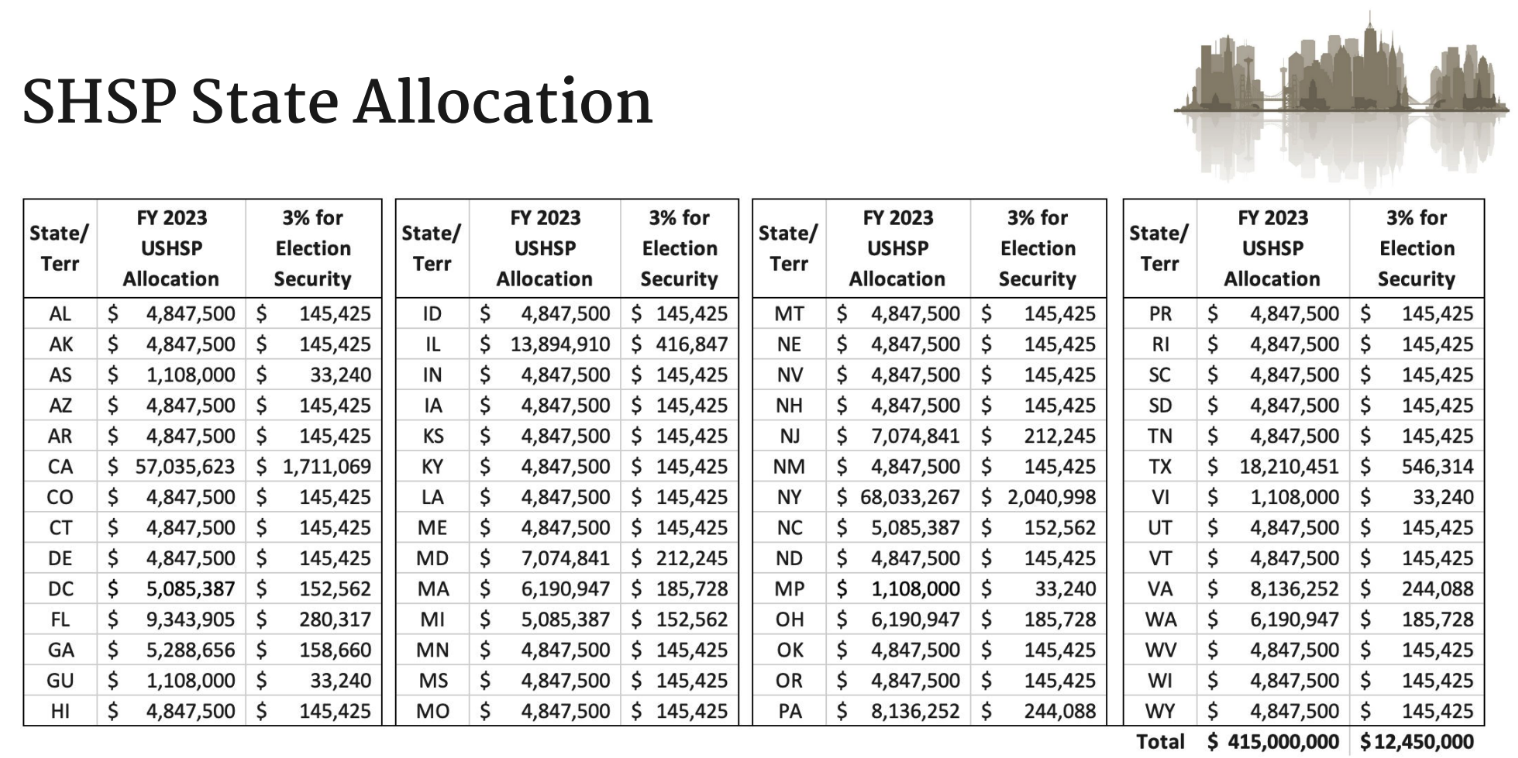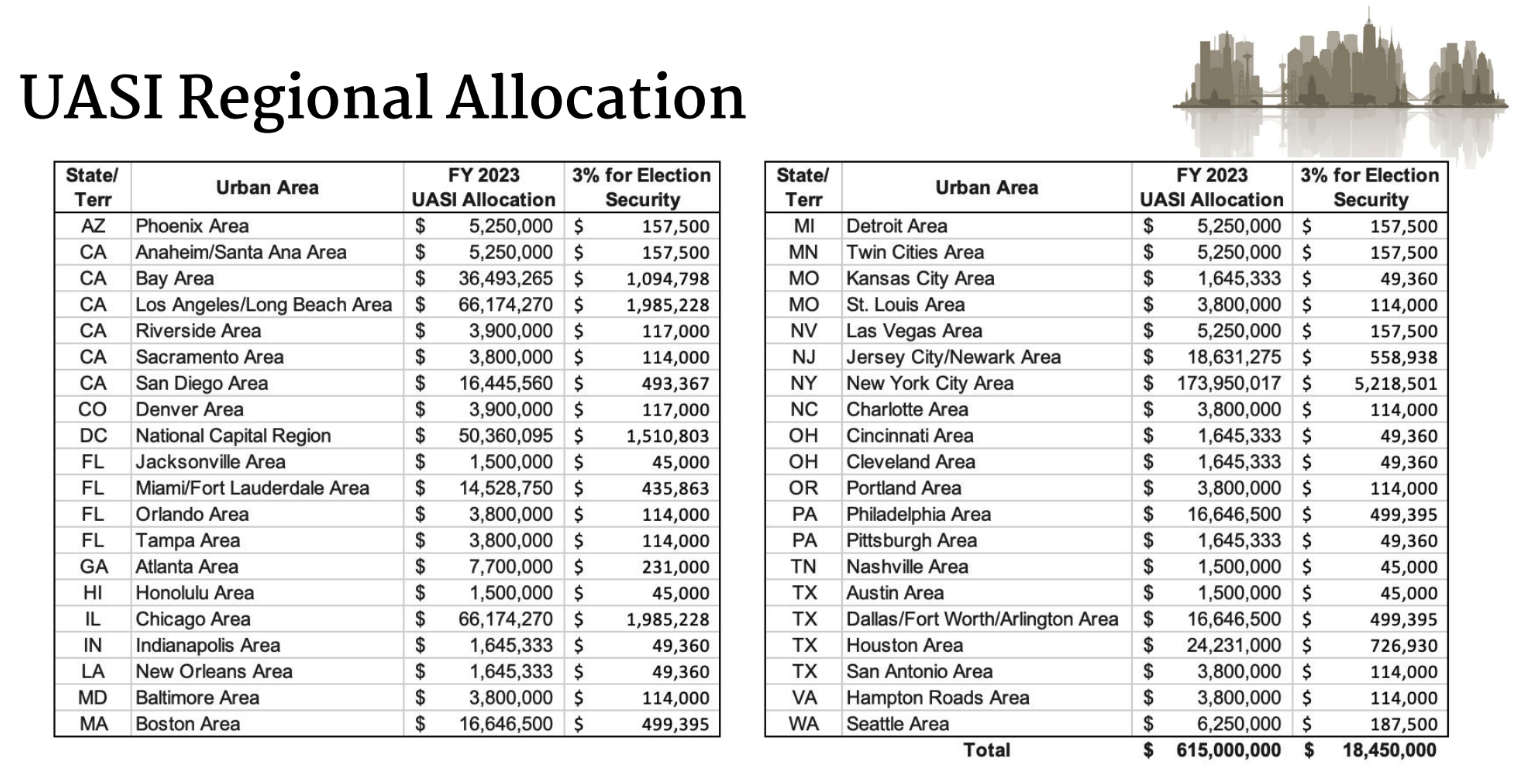Understanding the Homeland Security Grant Program
With the 2024 General Election on the horizon, we know it’s as important as ever that election officials like you have the resources you need to run secure elections. Today, we’re outlining two components of the Homeland Security Grant Program (HSGP) to help you better understand what resources are available to you from the federal government, and what you can do to advocate for the funding your election office needs.
In Fiscal Year 2023, the U.S. Department of Homeland Security (DHS) is providing $1.12 billion to enhance the ability of state, local, tribal, and territorial governments to prevent, prepare for, protect against, and respond to potential terrorist acts and other hazards. There are two grant programs that you should know about that make up the HSGP: the State Homeland Security Program, and the Urban Area Security Initiative. These grants are a separate stream of funding from traditional HAVA Security Grants, and are managed through FEMA. They have traditionally funded local agencies such as Fire, Police, EMS, and other local safety offices.
These grants are managed by a State Administrative Authority (SAA), and there is not an opportunity for local elections offices to apply independently. In order for projects to be included in this year’s grant applications, the SAA must agree that the project is a priority. Because of the 3% minimum spent, shovel-ready projects that can clearly demonstrate that they reduce the risk of terrorism in a community related to election administration (namely physical or cybersecurity) are more likely to be included. All applications are due by May 18, 2023, so local election offices are encouraged to meet with their SAA’s urgently.
SAA contacts differ from each state. Using FEMA’s list of grants officers we were able to locate the best contact info for each SAA, which you can find here organized alphabetically by state.
State Homeland Security Program (SHSP)
What is it?
SHSP assists state, local, tribal, and territorial (SLTT) efforts to build, sustain, and deliver the capabilities necessary to prevent, prepare for, protect against, and respond to acts of terrorism. All 56 states and territories are eligible to apply for SHSP funds, and the projects are managed by the chief elections officer in the state.
How much can states receive and what can the money be used for?
The DHS has allocated a total of $415M to SHSP. This year, a minimum of 3% of the budget is allocated specifically towards election security for state and local jurisdictions. These grants are managed by the chief election official in each state, and must support local elections jurisdictions in security upgrades. That can include:
- Implementing measures to enhance cybersecurity, including CISA training, and cybersecurity risk assessments
- Migrating online services to the “.gov” internet domain
-
Public awareness/preparedness campaigns discussing election integrity and security measures
Here’s a breakdown of allocation by state:
What can election officials do?
Because this is a statewide program, local election officials cannot apply directly for funds. Only the state administrative agency (SAA) has authority to submit grant applications to FEMA. Election officials can engage their SAA to ensure that they have everything they need in terms of justification, and they can advocate for statewide CISA training with local election offices. Please see this list of the contact information for the SAA in each state.
Completed applications must be submitted by the State Administrative Authority no later than 5 p.m. ET on May 18, 2023.
Urban Area Security Initiative (UASI)
What is it?
UASI assists high-threat, high-density Urban Area efforts to build, sustain, and deliver the capabilities necessary to prevent, prepare for, protect against, and respond to acts of terrorism.
There are 40 pre-established UASI regions that are high-density and at high risk for terrorism. These UASI regions are eligible to apply via their SAA.
How much can jurisdictions receive and what can the money be used for?
The DHS has allocated a total of $615M to UASI. Of that, $18.45M is available for regional election security.
Here’s a breakdown of the eligible urban areas and the funds allocated to them:
What can election officials do?
Similar to SHSP, local election officials cannot apply directly for funds. Only the state administrative agency (SAA) has authority to submit grant applications to FEMA. If you’re an election official from one of the jurisdictions covered by UASI, please see this list to find the contact information for your SAA.
Completed applications must be submitted no later than 5 p.m. ET on May 18, 2023.
What if my jurisdiction isn’t covered under UASI?
We encourage you to start advocating now for funds to run a smooth election in 2024. Here are a couple of steps you can take to advocate for the resources you need:
- Engage with your members of Congress to make it clear that you have additional funding needs.
- Develop and build a relationship with your state’s grants officer to ensure you’re fully utilizing local funds available to your office. There may be unclaimed funds, or you may be eligible for other streams of funding.
What can I prepare for next year?
We are hopeful that a minimum allocation for election security will continue into FY 2024. Regardless of whether your projects are approved this year, we recommend starting now in establishing relationships with your chief election official and SAA. In some circumstances, unspent funds may become available for small, ad-hoc federal grants. In other instances, this will allow your SAA more time to balance the grant application to include your urgent priorities.

